In today’s society, with the increasing depletion of marine resources, desalination technology has gradually become a field of attention. With the vigorous development of desalination, small desalination machine has become a new hot spot. Compared with large-scale desalination machine, small-scale machine has many advantages.
Marine resources occupy 71% of the earth, compared to its freshwater resources can be said to be quite rich. It is understood that so far, many islanders are still eating alkaline water, so we need to convert marine resources into fresh water resources that can be used. In response to the shortage of fresh water for island residents, a set of small-scale desalination machine has been carefully researched, applying the principle of total membrane method to solve the problem of water consumption for island and sea residents.
First of all, the small desalination machine is easy to carry and install because of its small size and light weight. This kind of machine can be conveniently placed on ships to supply drinking water to the crew, and can also be placed in outdoor camping to provide clean drinking water to travelers. In addition, small-scale machine does not need to occupy large areas of land and sea, and can be more flexible to cope with different environments and scenarios.
Secondly, small desalination machine has low energy consumption and lower operating costs. Compared with large-scale machine, small-scale machine consumes less energy and can therefore be operated more economically. This also means that in some remote areas, small equipment can provide clean drinking water more conveniently, bringing real benefits to local residents.
In addition, small desalination machine have lower maintenance costs. As the structure of small-scale equipment is relatively simple, maintenance is also easier. This also means that small machine has a longer lifespan and can provide clean drinking water more consistently.
Small desalination machine mainly uses the osmosis concept of reverse osmosis membranes, which utilizes the principle of osmosis to filter out the salts from seawater, discharging high concentrations of seawater and leaving clean water that can be consumed. This process becomes the osmosis pressure, give the water the appropriate pressure, the impurities in the water, salt removal, leaving clean water, to achieve the reverse osmosis desalination of seawater into drinkable clean water.
Compared with other processes, the membrane treatment process is used to better deal with microorganisms and particles in the water and protect the desalination machine. This equipment has the advantages of compact structure, easy installation, easy maintenance, small footprint, small size and strong applicability.




